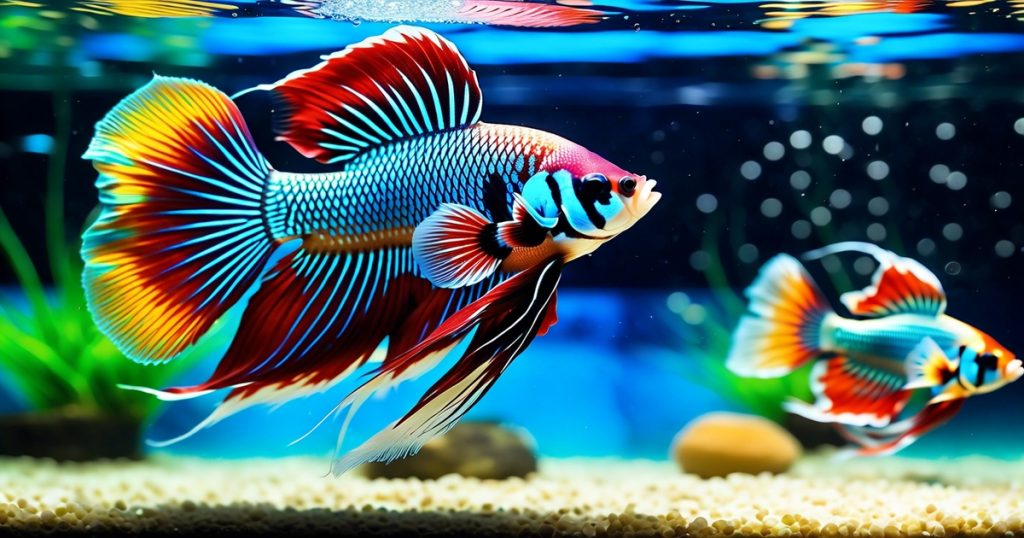Did you know that betta fish are highly intelligent and curious creatures with unique personalities? Many pet owners overlook the importance of providing stimulating toys for bored betta fish species. In this guide, we will dive into the fascinating world of creating engaging and enriching toys and a stimulating environment for your betta fish. From simple DIY projects to innovative ideas, we’ll explore various ways to keep your betta fish entertained and active. Whether it’s designing diy toys or crafting interactive feeding puzzles, there are endless possibilities to enhance your betta’s environment.
Table of Contents
ToggleUnderstanding Betta Fish Play Needs

Importance of Play for Betta Fish
Betta fish are intelligent creatures that require play, mental stimulation, and enrichment to thrive. Providing them with suitable toys and activities for enrichment is crucial for their overall well-being. Without proper mental engagement, bettas can become stressed or lethargic, leading to potential health issues.
Understanding the need for play in betta fish is essential for creating an enriching environment. By observing their natural behaviors, such as exploring their surroundings, chasing prey (or toy substitutes), and interacting with objects in their habitat, you can identify the types of toys and activities that will best cater to their play needs.
It’s important to note that while bettas may not play in the same way as dogs or cats, they do exhibit playful behaviors unique to their species. For instance, betta fish may enjoy swimming through hoops or tunnels made from safe materials like PVC pipes or silk plants. Floating objects like ping pong balls and betta fish toy can also stimulate them by encouraging exploration and interaction.
Creating Suitable Play Options
When considering how to make betta fish toys, it’s crucial to prioritize safety and suitability. Opt for items that won’t harm your betta if ingested or cause injury due to sharp edges. Safe options include soft plant-based ornaments, floating decorations, leaf hammocks near the water surface for resting periods, and even specially designed mirrors that allow bettas to interact with their own reflections without causing stress.
Recognizing Signs of Boredom in Betta Fish
Lack of Interest
Betta fish, when bored, may show a lack of interest in their surroundings. They might seem uninterested in exploring or interacting with the environment. This behavior can be observed when they spend most of their time resting at the bottom or near the surface of the tank without engaging in any activities.
Behavioral Changes
Aggressive or lethargic behavior can also indicate boredom in betta fish. If your betta is constantly flaring its fins, nipping at other fish, or showing signs of aggression, it could be a result of frustration due to lack of stimulation. Conversely, if your betta appears unusually lethargic and disinterested, it may be a sign that it needs more mental and physical engagement.
Observing changes in eating habits and activity levels, as well as betta tank, is crucial for identifying boredom. A bored betta might lose interest in food or exhibit reduced activity levels compared to its usual behavior. Keeping notes on their daily routines and behaviors can help you track these changes over time.
Materials Safe for Betta Fish Toys
Non-Toxic Materials
When creating betta fish toys, it’s crucial to use non-toxic materials. Toxic materials can harm bettas, so opt for safe options like silk plants and soft plastics. These materials are gentle on your betta’s delicate fins and won’t leach harmful substances into the water.
Researching safe materials is essential to ensure that the toys you make are harmless to your betta fish. Look for products specifically labeled as aquarium-safe or fish-friendly. Avoid using any items with sharp edges or small parts that could potentially injure your betta.
Using non-toxic materials not only keeps your betta fish safe but also provides them with stimulating and enriching toys to prevent boredom. By incorporating safe materials into their environment, you can promote a healthy and happy life for your beloved pet.
Interactive Betta Fish Toy Ideas
Floating Mirrors
Betta fish are known for their territorial nature, and floating mirrors can stimulate them by triggering this behavior. When a betta sees its reflection in the mirror, it may perceive it as an intruder in its territory. This can lead to flaring, a behavior where the betta puffs out its gills and spreads its fins aggressively. While this might seem like aggression, it’s actually a sign that the betta is engaged and stimulated.
Another way to use floating mirrors is by moving them around the tank occasionally. This helps prevent habituation, ensuring that the bettas remain interested and engaged with their stimulating toys.
Ping Pong Balls
Ping pong balls provide simple yet effective entertainment for bettas as they float on the water’s surface. Bettas often push these balls around or even nudge them with their noses, creating amusement for both the fish and anyone watching. These lightweight balls are safe for betta tanks, making them an ideal choice for providing enrichment without posing any harm to your pet.
You can enhance this toy further by placing treats inside some of the ping pong balls before adding them to your betta’s environment. As your pet interacts with these treat-filled balls, they get mental stimulation along with physical activity.
Laser Pointers
Laser pointers offer another engaging option for entertaining your betta fish. By directing the light across different areas of the tank, you can encourage your bettas to chase after it eagerly. This activity not only provides mental stimulation but also promotes exercise as they swim around following the elusive light beam.
Remember not to shine laser pointers directly onto your betta fish, as direct exposure may cause stress or confusion rather than healthy engagement.
Crafting Floating and Sinking Toys for Bettas
Variety in Play
Bettas are known for their playful nature, and providing a mix of floating and sinking toys can cater to their different preferences. Creating floating toys using cork or foam materials can keep bettas entertained as they interact with the objects on the water’s surface. On the other hand, sinking toys like ceramic caves or weighted PVC pipes offer variety in play by encouraging bettas to explore different depths within the aquarium.
Balancing the types of toys is crucial to ensure that bettas have diverse options for engagement. For example, if a betta fish prefers spending time near the surface due to its delicate fins, offering more floating toys would be beneficial. Conversely, if another betta enjoys exploring deeper areas of the tank, incorporating more sinking toys such as weighted decorations or hiding spots will provide enrichment.
Providing an assortment of toy types not only keeps bettas mentally stimulated but also encourages physical activity as they swim around and interact with various objects in their environment.
Creating Betta Fish Foraging and Exercise Toys
Encouraging Natural Foraging Behaviors
Betta fish are curious creatures that thrive on mental stimulation. Creating DIY puzzle feeders is a great way to encourage their natural foraging behaviors. By hiding food inside these toys, bettas have to work for their meals, just like they would in the wild. This not only provides them with a rewarding activity but also prevents overeating and obesity.
Moreover, rotating different types of toys regularly keeps your betta fish mentally engaged and physically active. Bettas have unique personalities, and some may prefer certain toys over others. By introducing new items into their environment frequently, you can cater to their preferences while preventing boredom.
Promoting Exercise Through Gentle Water Currents
Installing a gentle water current using a bubbler in your betta’s tank can promote exercise. The movement of the water encourages swimming and helps strengthen their fins. It also simulates the natural environment of bettas living in the wild where they encounter varying currents.
Having plenty of open space in the tank allows them to swim freely without obstructions. This freedom promotes movement and reduces stress by mimicking their natural habitat where they have ample room to explore.
Tips for Introducing New Toys to Betta Fish
Gradual Introduction
When introducing new toys to your betta fish, it’s essential to do so gradually. This helps reduce stress for the fish and allows them to acclimate to the new environment. For example, if you’re adding a floating mirror or a small tunnel, start by placing it in the tank for short periods each day.
Betta fish are sensitive creatures, and sudden changes can cause distress. By slowly integrating new toys into their habitat, you give them time to explore without feeling overwhelmed. This approach also enables you to observe how they interact with the toy and whether they show signs of discomfort.
Monitoring Reactions
Observing your betta fish’s initial reactions is crucial when introducing new toys. Pay attention to their behavior – do they seem curious, indifferent, or stressed? If they exhibit signs of distress or avoidance towards the toy, it may not be suitable for them.
Maintaining and Rotating Betta Toys for Continued Engagement
Regular Inspection for Safety
Regularly inspecting toys for wear and tear is crucial to ensure the safety of bettas. Sharp edges or small, loose parts can pose a risk to your fish. By examining the toys, you can promptly remove any damaged items that could harm your betta.
It’s important to remember that bettas are curious creatures and may explore their toys with their fins and mouths. If a toy shows signs of deterioration, such as peeling paint or rough surfaces, it’s best to replace it with a new one. This simple practice helps maintain a safe environment for your pet.
Rotating Toys for Continuous Interest
Rotating toys every few weeks prevents habituation in bettas. Just like humans, these fish can become bored with familiar surroundings. By introducing new toys or repositioning existing ones, you provide mental stimulation and keep your betta entertained.
Consider having a selection of different types of toys on hand – from floating logs and tunnels to colorful balls with holes – so your betta can engage in various activities throughout its environment. For example: if you notice that your fish has been paying more attention to the floating log lately, try swapping it out with the colorful ball next time.
Final Remarks
You’ve learned how crucial it is to keep your betta fish entertained and mentally stimulated. By recognizing the signs of boredom and understanding their play needs, you can now provide a variety of safe and interactive toys to keep them engaged. From floating and sinking toys to foraging and exercise tools, there’s a wide range of options to cater to your betta’s preferences. Remember to introduce new toys gradually and rotate them regularly to maintain your fish’s interest.
Now that you have the know-how, it’s time to put it into action! Get creative and start crafting or purchasing toys that will bring joy and enrichment to your betta fish’s life. Your efforts will not only keep your betta happy but also strengthen the bond between you and your aquatic friend. Keep exploring new ways to keep your betta stimulated, and enjoy watching them thrive in their enriched environment.
